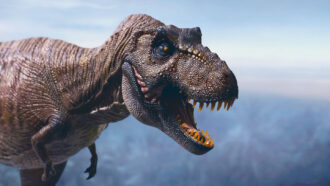All Stories
-
 Animals
AnimalsFreeze-drying turned a woolly mammoth’s DNA into ‘chromoglass’
The 3-D structure of this now-glassy DNA revealed similarities — and differences — between woolly mammoths and elephants.
-
 Materials Science
Materials ScienceScientists Say: Goldene
Making this metallic, two-dimensional (2-D) material is difficult — but super-thin sheets of gold could have uses in electronics and chemistry.
-
 Animals
AnimalsBalmy ‘saunas’ help frogs fend off a deadly fungus
Hanging out in small sun-warmed hideaways could help some frogs resist deadly chytrid fungus, a new study finds.
By Skyler Ware -
 Fossils
FossilsStunning trilobite fossils include never-before-seen soft tissues
Well-preserved fossils from Morocco help reveal the weird way trilobites ate and perhaps why these iconic animals went extinct.
-
 Space
SpaceAstronomers caught a supermassive black hole turning on for the first time
The black hole at the center of a not-too-distant galaxy switched from being dim and quiet to bright and active.
By Adam Mann -
 Humans
HumansHow much more can Olympic speed records fall?
The human body can go faster than current world records on land and in water. But to reach full potential, our technique must be perfect.
-
 Science & Society
Science & SocietyScientists Say: Thought experiment
Thinking through imaginary, sometimes absurd, scenarios can catalyze new ways of thinking.
-
 Brain
BrainJust how brainy was a T. rex?
A debate rages over how to count brain cells in dinosaurs. At issue: figuring out how these extinct animals’ likely behaved.
By Freda Kreier -
 Earth
EarthHawaii’s Kilauea volcano recently erupted like a stomp rocket
This appears to be a newfound type of eruption. It could only be recognized because of the extensive monitoring of Kilauea's crater.
-
 Plants
PlantsThis squid-like ‘fairy lantern’ plant is new to science
A newly named species of fairy lantern — a parasitic plant — sports tentacles and grows among leaf litter and rotten logs in Malaysian rainforests.
By Jake Buehler -
 Space
SpaceSpace tourists could face out-of-this-world health risks
As commercial spaceflight starts to take off, a new project — the Space Omics and Medical Atlas — documents potential health impacts to travelers.
By Adam Mann -
 Animals
AnimalsScientists Say: Beakiation
Parrots use this clever sidestepping motion to maneuver along thin branches.